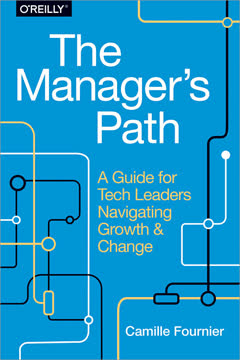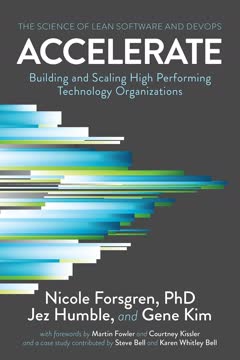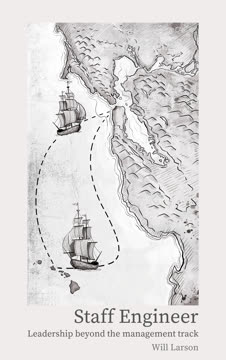Key Takeaways
1. Master the art of managing humans by understanding their quirks and motivations
"Your job in a one-on-one is to give the smallest voice a chance to be heard, and I start with a question: 'How are you?'"
Understand your team. As a manager, your primary responsibility is to understand and support the individuals on your team. This involves recognizing their unique personalities, work styles, and motivations. Regular one-on-ones are crucial for building relationships and gathering insights.
Tailor your approach. Different team members require different management styles. Some may thrive on autonomy, while others need more guidance. By understanding each person's needs, you can adapt your leadership approach to maximize their potential and job satisfaction.
Foster psychological safety. Create an environment where team members feel comfortable sharing their thoughts, concerns, and ideas. This openness leads to better problem-solving, innovation, and overall team performance.
2. Foster a culture of open communication and trust to build high-performing teams
"If they don't trust you, they aren't going to say shit, so there will be nothing to hear."
Build trust through transparency. Be open about company goals, challenges, and decision-making processes. Share information freely and encourage your team to do the same. This transparency builds trust and helps team members feel invested in the company's success.
Encourage diverse perspectives. Actively seek out and value different viewpoints within your team. This diversity of thought leads to better problem-solving and innovation. Create opportunities for all team members to contribute their ideas and opinions.
Address conflicts constructively. When disagreements arise, address them promptly and professionally. Use conflicts as opportunities to improve communication and strengthen relationships within the team.
3. Embrace the chaos of software development while maintaining structure
"Process creates a delectable, healthy tension between those who measure and those who create."
Balance flexibility and structure. Recognize that software development is inherently chaotic, but structure is necessary for productivity. Implement lightweight processes that provide guidance without stifling creativity or agility.
Adapt to changing circumstances. Be prepared to adjust your approach as projects evolve and new challenges arise. Encourage your team to be adaptable and resilient in the face of change.
Foster a culture of continuous improvement. Regularly review and refine your processes, seeking input from team members. Encourage experimentation and learning from both successes and failures.
4. Recognize and nurture different personality types within your engineering team
"A good referee knowsWhen the meeting is nowhere near the stated agenda, but everyone in the room is showing all the nonverbal signs of progress—so screw it, let's see where it goes."
Identify key personality types. Recognize common engineering personalities, such as:
- The Perfectionist: Strives for flawless code but may struggle with deadlines
- The Innovator: Generates creative solutions but may resist established processes
- The Workhorse: Reliably completes tasks but may lack initiative
Leverage strengths and mitigate weaknesses. Assign tasks and roles that play to each team member's strengths. Provide support and guidance to help individuals overcome their weaknesses.
Promote collaboration among diverse personalities. Encourage teamwork between different personality types to foster creativity and balance. Create opportunities for knowledge sharing and mentorship within the team.
5. Navigate organizational politics and change with strategic finesse
"Reorgs affect the entire company. Everyone has an opinion and that means group think of a magnitude you're unfamiliar with."
Understand the political landscape. Identify key stakeholders, decision-makers, and influencers within your organization. Build relationships and alliances to support your team's goals and initiatives.
Communicate effectively during change. During reorganizations or other major changes, provide clear, consistent communication to your team. Address concerns promptly and honestly, while focusing on the positive aspects of the change.
Be a change agent. Position yourself and your team as valuable contributors to organizational change. Proactively identify opportunities for improvement and present well-thought-out proposals to leadership.
6. Cultivate a learning environment that encourages growth and innovation
"The nerd as system thinker is a point I've been making since I wrote the Nerd Handbook, and one I explore further in Being Geek (O'Reilly, 2010)."
Promote continuous learning. Encourage your team to stay up-to-date with new technologies and industry trends. Provide resources and opportunities for professional development, such as training, conferences, and mentorship programs.
Foster a culture of experimentation. Create space for team members to explore new ideas and approaches. Encourage controlled risk-taking and view failures as learning opportunities rather than setbacks.
Recognize and reward innovation. Celebrate creative solutions and innovative thinking within your team. Implement a system for sharing and evaluating new ideas, and provide support for promising initiatives.
7. Balance technical expertise with people management skills for effective leadership
"Your job as a manager is to transform his glaring deficiency into a strength by finding the best person to fill it and trusting him to do the job."
Maintain technical proficiency. Stay involved in technical discussions and decision-making to maintain credibility with your team. Regularly update your own technical skills to understand the challenges your team faces.
Develop strong people management skills. Focus on improving your emotional intelligence, communication, and conflict resolution abilities. These soft skills are crucial for effectively leading and motivating your team.
Delegate and empower. Trust your team members with important tasks and decisions. Provide guidance and support, but avoid micromanaging. This approach allows you to focus on higher-level leadership responsibilities while developing your team's skills and confidence.
8. Implement effective processes without stifling creativity and productivity
"Embrace the ambiguity of their experiment. Agreeing to let them experiment and obsess about a fascinating project is only half the game."
Design lightweight processes. Create processes that provide structure and guidance without becoming burdensome. Focus on the essential elements that improve efficiency and quality.
Regularly review and refine. Continuously evaluate your processes to ensure they remain effective and relevant. Seek input from your team and be willing to adapt or eliminate processes that no longer serve their purpose.
Allow for flexibility. Recognize that different projects or team members may require variations in process. Be open to adjusting your approach when necessary to accommodate unique situations or creative problem-solving.
9. Handle crises and difficult situations with calm and decisive action
"When the sky is falling, everybody is watching. Everybody wants status an hour ago."
Stay calm under pressure. Your demeanor sets the tone for your team. Maintain a composed and confident attitude, even in high-stress situations.
Gather information quickly. Assess the situation by collecting relevant facts and perspectives. Avoid making hasty decisions based on incomplete information.
Take decisive action. Once you have a clear understanding of the problem, act decisively to address it. Communicate your plan clearly to your team and stakeholders, providing regular updates on progress.
10. Develop your career strategically, always seeking new challenges and opportunities
"If you want your nerd to rock your world by building something revolutionary, you want them chasing the Second High."
Set clear career goals. Define your long-term career aspirations and create a plan to achieve them. Regularly reassess and adjust your goals as your interests and circumstances change.
Seek diverse experiences. Take on new challenges and responsibilities that broaden your skill set and perspective. This may involve lateral moves or cross-functional projects within your organization.
Build a strong professional network. Cultivate relationships with colleagues, mentors, and industry peers. These connections can provide valuable insights, support, and opportunities throughout your career.
Last updated:
FAQ
What's Managing Humans about?
- Focus on Management: Managing Humans by Michael Lopp delves into the complexities of managing software engineering teams, blending humor with real-life experiences to offer leadership insights.
- Semi-Fictional Stories: The book uses narratives inspired by Lopp's experiences at companies like Apple and Pinterest, illustrating management concepts through relatable characters and situations.
- Human-Centric Approach: Lopp stresses the importance of understanding and connecting with team members, emphasizing that successful management involves addressing the unique needs of individuals.
Why should I read Managing Humans?
- Practical Insights: The book provides actionable advice for both new and experienced managers, aiding them in navigating the challenges of leading technical teams.
- Engaging Style: Lopp's humorous and candid writing style makes complex management concepts accessible and enjoyable to read.
- Real-World Applications: Readers can apply lessons from Lopp's experiences to their own management practices, enhancing team dynamics and productivity.
What are the key takeaways of Managing Humans?
- Connection is Key: Great managers must connect with their team members to understand their motivations and needs.
- Embrace Complexity: Lopp encourages managers to embrace the chaotic nature of human interactions and to be flexible in their approaches.
- Communication Matters: Effective communication is crucial for successful management, with strategies provided for improving clarity and understanding within teams.
What are the best quotes from Managing Humans and what do they mean?
- "You must see the people who work with you.": Highlights the importance of recognizing and understanding individual team members to foster a supportive work environment.
- "Better is the enemy of done.": Warns against perfectionism, suggesting that striving for perfection can hinder progress and completion of projects.
- "Management is chess.": Compares management to chess, indicating that it requires strategic thinking and foresight to navigate complex organizational dynamics.
What is the "Rands Test" in Managing Humans?
- Assessment Tool: The Rands Test is a set of 11 questions designed to evaluate the health of a team and the effectiveness of communication within it.
- Focus on Clarity: Questions address whether team members have regular one-on-ones, understand company strategy, and feel comfortable expressing their thoughts.
- Actionable Insights: By answering these questions, managers can identify areas for improvement in team dynamics and communication practices.
How does Lopp define "Stables" and "Volatiles" in Managing Humans?
- Stables: Team members who prefer structure, process, and predictability, contributing to a stable work environment.
- Volatiles: Thrive on risk and disruption, often challenging the status quo and pushing for innovation, which can lead to conflict with Stables.
- Balancing Act: Both types are essential for a healthy team dynamic, and managers should encourage a balance between stability and innovation.
What is the significance of "The Hotel Giraffe" metaphor in Managing Humans?
- Unexpected Situations: Illustrates the absurdity of unexpected challenges in management, emphasizing the need for adaptability.
- Self-Reflection: Encourages managers to reflect on their stress levels and how they handle unexpected challenges.
- Awareness of Stress: The giraffe symbolizes the importance of recognizing when stress affects performance and addressing it proactively.
What does Lopp mean by "Management via Worry and Crisis"?
- Worry Management: Refers to managers who react to potential problems with excessive concern, leading to unproductive meetings.
- Crisis Management: Describes managers who thrive in crisis situations, using them to demonstrate their value, but warns against relying solely on crises for motivation.
- Balanced Approach: Advocates for a balanced approach where managers can be proactive rather than reactive, fostering a healthier work environment.
How does Lopp suggest handling "Information Starvation"?
- Information Conduit: Managers should act as conduits for information, ensuring team members receive necessary updates and context.
- Preventing Rumors: Open communication prevents the spread of rumors and misinformation arising from a lack of clarity.
- Regular Check-Ins: Emphasizes the importance of regular check-ins and updates to keep the team informed and engaged.
What is the "soak" method in Managing Humans?
- Definition of Soaking: Involves allowing your mind to ponder a problem over time, rather than rushing to a solution, leading to more creative outcomes.
- Active and Passive Soaking: Active soaking involves gathering information, while passive soaking lets your mind wander and make connections.
- Encouraging Original Thought: Aims to foster original thought and strategic decision-making by transforming emotional reactions into well-considered responses.
What is the "Nerd Attention Deficiency Disorder" (NADD) in Managing Humans?
- Definition of NADD: A humorous term describing the tendency of nerds to juggle multiple tasks and distractions simultaneously.
- Characteristics of NADD: Individuals thrive on rapid-fire content and multitasking, which can lead to both productivity and chaos.
- Managing NADD: Emphasizes creating environments that allow for focused work and occasional chaos, supporting team members effectively.
What are "incrementalists" and "completionists" in Managing Humans?
- Incrementalists: Focus on making steady progress and achieving short-term goals, prioritizing getting things done over perfection.
- Completionists: Strive for perfection and long-term solutions, driven by the desire to do things right, resisting quick fixes.
- Balancing Both Types: Having both types on a team leads to more effective problem-solving and innovation when managed well.
Review Summary
Managing Humans receives mixed reviews, with an average rating of 3.93/5. Readers appreciate its insightful advice on managing software engineers and its entertaining writing style. Many find it helpful for new managers and relatable for those in tech. However, some criticize its reliance on stereotypes and outdated perspectives. The book's structure as a collection of blog posts is both praised for readability and criticized for lack of cohesion. While some readers highly recommend it, others find it less applicable outside Silicon Valley or for non-stereotypical engineers.
Similar Books










Download PDF
Download EPUB
.epub digital book format is ideal for reading ebooks on phones, tablets, and e-readers.





